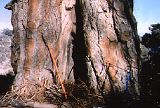Torrey Pine

Torrey pines occur naturally only in two limited coastal California sites and are the rarest species of North American pines. The first population was discovered on the coast at the mouth of the Soledad River near San Diego. This population, now within the Torrey Pine State Reserve, includes an estimated 4,000-5,000 trees, mostly larger, reproductive individuals, some of which were planted by concerned caretakers. In 1988, following a damaging wind storm and several seasons of drought, this mainland stand was severely attacked by bark beetles, and hundreds of trees were killed. The beetles were controlled by trapping using a chemical attractant, which probably saved the bulk of the mainland trees (Berson 1992).
Courtesy S. Veirs, USGS

The second population occurs on Santa Rosa Island (now a part of Channel Islands National Park) and was described (Brandegee 1888) as a stand of about 100 trees with plenty of vigorous young trees (Fig. 1). This stand was probably limited by the species' sensitivity to the occasional fires that burned through the island vegetation (S. Veirs, U.S. Geological Survey, Davis, California, unpublished fire history; Fig. 2). Sheep were introduced to the island by Europeans about 1840, and they controlled fires by consuming most of the island's vegetation. The sheep were removed early in the twentieth century and were replaced by cattle. In the continued absence of fire, the stand has increased to 4,200 individuals, including many seedlings and young trees (Veirs, unpublished data; Fig. 3).
Courtesy S. Veirs, USGS

The native populations of Torrey pines are at considerable risk because of their small numbers and limited natural distribution. Natural influences, including drought, insects, and fire, pose serious hazards and probably account for the present limited distribution of this species. Torrey pines are relicts of the Pleistocene flora of California; this relict flora has apparently been pushed to the brink of extinction by natural processes--probably climatic changes--over the past 10,000 years (Vogl et al. 1988). Careful monitoring, understanding, and management are essential to perpetuating the native populations of Torrey pines.
U.S. Geological Survey
Biological Resources Division
Western Ecological Research Center
University of California
Davis, California 95616
References